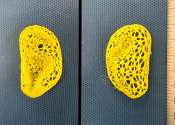Cartilage is a type of dense connective tissue existing within many joints. It is composed of specialized cells called chondrocytes that produce a large amount of extracellular matrix composed of collagen fibers, abundant ground substance rich in proteoglycan, and elastin fibers. Cartilage is classified in three types, elastic cartilage, hyaline cartilage and fibrocartilage, which differ in the relative amounts of these three main components.
Cartilage is found in many areas in the body, including the articular surface of the bones, the rib cage, the ear, the nose, the bronchial tubes and the intervertebral discs. Its mechanical properties are intermediate between bone and dense connective tissue like tendon.
Unlike other connective tissues, cartilage does not contain blood vessels. The chondrocytes are fed by diffusion, helped by the pumping action generated by compression of the articular cartilage or flexion of the elastic cartilage. Thus, compared to other connective tissues, cartilage grows and repairs more slowly.









